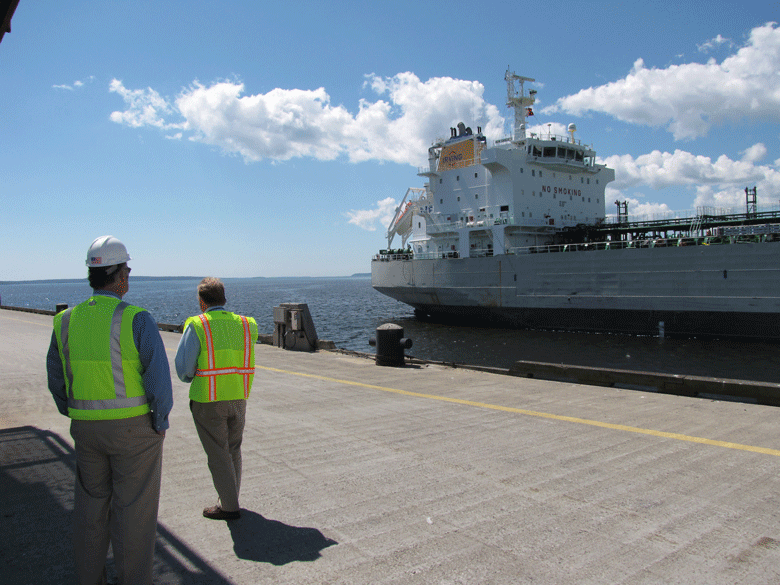The future of Maine’s three state-supported shipping ports is bright, says Matt Burns, director of the Maine Port Authority.
“We have a lot of activities on our plate out to the end of the decade,” Burns said during a Feb. 14 online presentation hosted by the Waterfront Alliance, a Portland working waterfront advocacy group.
Chief among those activities are a growing capacity for refrigerated cargo at the International Marine Terminal in Portland and the role likely to be played in developing offshore wind turbines by Mack Point or Sears Island in Searsport. The third port, Eastport, is a focus for the authority as it works to develop business there.
The state has invested nearly $100 million in the port since 2009, Burns said.
Burns, whose career included stints on dredge, drill, and cruise ships, has been executive director of the port authority, the quasi-state agency, for less than a year, but he had served as interim director. The authority’s mission is to develop, maintain, and promote port and intermodal facilities “to stimulate commerce and enhance the global competitiveness” of the state.
Portland has lost some ship traffic as oil deliveries have declined, Burns said, though he acknowledged the carbon-reduction represented by that decline is welcomed. He praised the work Iceland-based operator Eimskip has done in Portland. The company operates in ports around the world.
“They’ve brought the freight,” he said, and have maintained weekly ship service since 2018.
The state has invested nearly $100 million in the port since 2009, Burns said.
“Almost everything is brand-new in the last five years,” he said.
Construction of a long-planned 107,000-square-foot, $55 million cold storage facility was set to begin in late winter. The project, which will include photovoltaics offsetting 20% of its energy use, is expected to be fully operational February 2024.
Burns said the port now uses 150 plug-in refrigerator containers, but that number will grow to 450. Radiation scanning equipment to screen incoming containers also will be added to the facility.
The port is aiming to handle 3,000 20-foot-equivalent—or TEU—containers annually, up from the current 900 TEU capacity, with the infrastructure expected to be in place by the end of the decade.
“Eimskip is considering larger vessels,” he reported. “They’re trying to find ways to bring additional volume into the port,” either with more ships or bigger ships.
Adding larger cranes, yard trucks, dredging the berth from 32 feet at mean low tide to 35 feet, and creating more pier surface are all goals.
A plan by the state of Maine to locate a dozen floating wind turbines to demonstrate and study wind power potential in the Gulf of Maine is approaching implementation. The Pine Tree Offshore Wind project would be sited south of Monhegan Island, pending approvals, but proponents hope the turbines will be in the water this year.
The turbines, Burns noted, would be the largest structures in Maine.
“We’d be building skyscrapers, essentially,” he said.
The state is considering Searsport as a port location, weighing using the existing Mack Point facility on the mainland, or Sears Island about 500 yards away, or a combination of both. Eastport’s Estes Head facility is also in the running.
Deep water access, no overhead restrictions, a cargo staging area, heavy loading capacity (up to 6,000 pounds per square foot), and 1,500 feet of dedicated wharf frontage are needed to store, assemble, and launch the floating turbines, Burns said. The turbines would be towed to the chosen site.
“We want to do all of that at one of our ports,” he said. “It’s exciting stuff.”
Though Searsport is a likely location for the work, Eastport is still under consideration, he added. Groups based in Searsport and Islesboro have argued that Sears Island is not appropriate for the activity. The state-owned island has been divided, with 650 acres put in conservation, and the remaining 300 acres reserved by the Department of Transportation for possible port uses.
“We’re collecting data from all sites,” Burns said, and working with stakeholders.
The existing port at Searsport needs dredging, he added, though the railroad link to that port is more viable with recent ownership changes. Maine now has two class 1 lines, CSX and Canadian Pacific, he said, with CSX purchasing Pan Am Railways and Canadian Pacific acquiring Central Maine & Quebec Railway in the last year.
Eastport remains a challenge.
“We’re trying to fund new opportunities for Eastport,” Burns said, and it now has a mobile harbor crane, joining Portland and Searsport in having that equipment.
The port authority has its own goals, Burns said, which include developing a comprehensive plan for the ports that looks ten to 20 years ahead, completing several grant-funded projects, hiring additional staff, and developing a more visible presence in the state.





